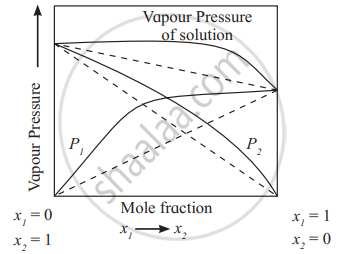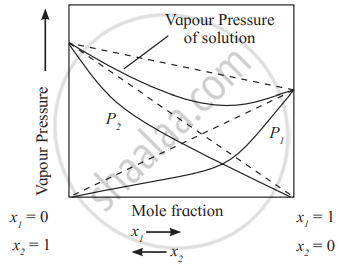Advertisements
Advertisements
Question
Explain with reasons and diagrams, the positive and negative deviations from Raoult’s law shown by nonideal solutions.
Solution
- Positive deviation from Raoult’s law:
The solutions in which solute-solvent intermolecular attractions are weaker than those between solute-solute molecules and solvent-solvent molecules, exhibit positive deviations. The vapour pressures of such solutions are higher than those of pure components as shown in the diagram.
e.g. The solutions of ethanol + acetone, carbon disulphide + acetone show positive deviations from Raoult’s law.
Positive derivations from Raoult's law - Negative deviation from Raoult’s law:
The solutions in which the interactions between solvents and solute molecules are stronger than solute-solute or solvent-solvent interactions, exhibit negative deviations. The vapour pressures of such solutions are lower than those of pure components as shown in the diagram.
e.g. Solutions of phenol + aniline, chloroform + acetone exhibit negative deviations from Raoult’s law.
Negative derivations from Raoult's law
APPEARS IN
RELATED QUESTIONS
Choose the most correct option.
The vapour pressure of a solution containing 2 moles of a solute in 2 moles of water (vapour pressure of pure water = 24 mm Hg) is ______.
Choose the most correct option.
Vapour pressure of a solution is _______.
Answer the following in one or two sentences.
State Raoult’s law for a solution containing a nonvolatile solute.
Answer the following.
Using Raoult’s law, how will you show that ΔP = `"P"_1^0 "x"_2`? Where, x2 is the mole fraction of solute in the solution and `"P"_1^0` vapour pressure of pure solvent.
A mixture of benzene and toluene contains 30% by mass of toluene. At 30 °C, vapour pressure of pure toluene is 36.7 mm Hg and that of pure benzene is 118.2 mm Hg. Assuming that the two liquids form ideal solutions, calculate the total pressure and partial pressure of each constituent above the solution at 30 °C.
What type of solutions exhibit positive deviations from Raoult’s law?
What is enthalpy change and volume change of mixing of two components forming an ideal solution?
The vapour pressures of pure liquids A and B are 0.600 bar and 0.933 bar respectively, at a certain temperature.
What is the mole fraction of liquid B in the solution when the total vapour pressure of their mixture is 0.8 bar?
Distinguish between ideal and non-ideal solutions.
With the help of vapour pressure-temperature curves for solution and solvent, explain why boiling point of solvent is elevated when a nonvolatile solute is dissolved into it.
The vapour pressure of a pure solvent at a certain temperature is 0.0227 bar. What is the vapour pressure of a solution containing 6 g of solute (M = 60 g/mol) in 50 g of solvent?
Which of the following statements is INCORRECT?
Which of the following metals is refined by vapour phase refining in Mond process?
Which of the following is NOT nonideal solution?
9 gram anhydrous oxalic acid (mol. wt. = 90) was dissolved in 9.9 moles of water. If vapour pressure of pure water is pf the vapour pressure of solution is ______.
If 1 mole of ____________ is added to 1 dm3 of water, the boiling point of water will decrease.
5.0 g of sodium hydroxide (molar mass 40 g mol-1) is dissolved in little quantity of water and the solution is diluted upto 100 mL. What is the molarity of the resulting solution?
18 g of glucose (C6H12O6) is added to 178.2 g of water. The vapour pressure of water for this aqueous solution is ______.
A solution having highest vapour pressure is ______.
Explain the variation of vapour pressures with mole fractions of binary solutions of two volatile liquids forming ideal solutions.
Write the relationship between mole fraction of solvent and vapour pressure of solution.
